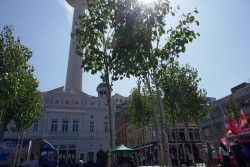Liverpool, a frontrunner city in re-naturing public spaces
If you happen to swing by Liverpool in the future, you will probably see a tree urban drainage system in Bold Street, where people frequently shop. Surface water flooding is a problem in many cities. Rainwater cannot penetrate cemented soil, and storms often overwhelm available sewage systems affecting properties and livelihoods. "We will introduce large street trees as part of a sustainable urban drainage system, designed to soak up excess local surface water and reduce the risk of localised flooding,” explains Juliet Staples, from the Liverpool City Council. Sustainable urban drainage systems (SUDS) can slow the water’s flow, reduce the volume to drain and even improve the final water quality. This is because the trees are planted in an infiltration trench, which can also remove pollutants through physical adsorption onto the material (soil, stones for example) with which the ditch is filled. Moreover, the substrate in which these trees will grow may include biochar, a charcoal that is able to increase soil retention of nutrients, and to trap urban pollutants avoiding their leaching into groundwater. This is one of the solutions that Liverpool is currently exploring under the EU project URBAN GreenUP, together with other “frontrunner” cities, namely Valladolid, Spain, and Izmir, Turkey. They are designing and testing out new nature-based solutions, in the hopes of mitigating the effects of climate change, and improving air quality and water management. Another measure that they are looking into is planting new vegetation across the city. Trees are able to capture and store carbon, and create a physical barrier to intercept fine particulate pollutants. They will be selected based on the species that transpire at high rates so that the city can take maximum advantage of their cooling effect. To show these benefits, the city centre hosted a pop up forest during the EU Green week. Clare Olver, from the Mersey Forest, which is one of the organisers of the initiative and also member of the project, explains: “Fifteen large canopied trees in containers transformed Williamson Square for a day. A thermal imaging camera was used to visually demonstrate the cooling effect provided by the tree canopy.” The pop up forest symbolised the effectiveness of the planned arboreal interventions, as they are expected to reduce the temperature by 2-4°C during summer and the organic gas evaporative emissions by 2%. In addition, the CO2 level is expected to decrease by 5.55 tons per year due to the presence of these trees. Some citizens could also compare the temperature measured under the tree canopy with that of the unshaded square. This opened a discussion on the multiple benefits of green infrastructure in urban environments. The Mersey Forest is a partnership of local authorities, landowners and communities promoting a long-term planting programme across Merseyside and North Cheshire. They planted 9 million trees so far. Relevant economic benefits are expected from this initiative, such as increased employment in land management and the tourism sector (180 new jobs have been created since 2014) and raised property values. One more nature-based intervention implemented in Liverpool will be the pollinators' walls, which will provide buildings with green surfaces where bees can find a safe place to feed, rest and thrive. They are primarily composed of plants that are particularly suited to pollinators, though “bug hotels” may also be incorporated in these walls. The structures are as varied as the insects that inhabit them. Read more: http://www.urbangreenup.eu/news--events/liverpool--a-frontrunner-city-in-re-naturing-public-spaces.kl
Keywords
re-naturing, green economy, water management, trees, nature-based interventions, bees
Countries
United Kingdom



